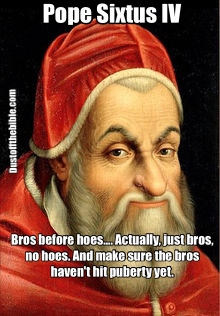It’s been almost 24 hours since I’ve been harassed by someone so it’s time to post something controversial.
 Pope Sixtus IV (1471–1484)
Pope Sixtus IV (1471–1484)
According to the published chronicle of the Italian historian Stefano Infessura, “Diary of the City of Rome”, Sixtus was a “lover of boys and sodomites” – awarding benefices and bishoprics in return for sexual favours, and nominating a number of young men as cardinals, some of whom were celebrated for their good looks. However, Infessura had partisan allegiances to the Colonna and so is not considered to be always reliable or impartial. [Stefano Infessura, Diario della città di Roma (1303-1494), Ist. St. italiano, Tip. Forzani, Roma 1890, pp. 155-156]
Pope Sixtus IV financed his wars by selling church offices to the highest bidders. He used the papacy to enrich himself and his family, for no less than eight cardinals were his nephews, some being given the position of cardinals. These are not disputed facts.
 Pope Leo X (1513–1521)
Pope Leo X (1513–1521)
Pope Leo X was accused, after his death, of homosexuality (Francesco Guicciardini and Paolo Giovio). It has been suggested he may have had ulterior motives in offering preferment to Marcantonio Flaminio. Zimmerman notes Giovio’s “disapproval of the pope’s familiar banter with his chamberlains – handsome young men from noble families – and the advantage he was said to take of them.” [The accounts of these two men were recorded in their own writings]
Ferdinand Gregorovius (1821-91), the great German theological historian who was never unduly prejudiced against popes, considered him “one of the most profane and most unecclesiastical figures that ever occupied the chair of St Peter“, and said that there was “not a trace of Christian piety in him” (Geschichte der Stadt Rom im Mittelalter [“History of Rome in the Middle Ages”], 1859-72, trans. 1895-1902; quoted in Crises in the History of the Papacy, Dr Joseph McCabe, Putnam, 1916, ch. vi, “The Papacy in the Decline”).
 Pope Julius III (1550–1555)
Pope Julius III (1550–1555)
Pope Julius‘ lasting fame was around his nepotism and favouritism. One notable scandal surrounded his adoptive nephew, Innocenzo Ciocchi Del Monte, a 13 or 14-year old beggar-boy whom the future Pope had picked up on the streets of Parma some years earlier and with whom he had allegedly fallen in love.
On being elected to the Papacy Julius raised the now 17-year old but still uncouth and quasi-illiterate Innocenzo to the cardinalate, appointed him cardinal-nephew, and showering the boy with benefices.[Source]
It was that boy whom he was admitted to having a sexual relationship with. In Italy it was said that Julius showed the impatience of a “lover awaiting a mistress” while awaiting Innocenzo’s arrival in Rome and boasted of the boy’s prowess in bed, while the Venetian ambassador reported that Innocenzo Del Monte shared the pope’s bed “as if he [Innocenzo] were his [Julius’s] own son or grandson.”[Source]
 Pope Paul II (1417 – 1471)
Pope Paul II (1417 – 1471)
Pope Paul III died on July 26, 1471 of a stroke, allegedly whilst being sodomized by a page boy. After his death, one of his successors (Platina) suggested that he should rather have been called Maria Pietissima, “Our Lady of Pity”, because he was inclined to break into tears at times of crisis. Some historians have suggested the nickname was rather due either to Paul propensity to enjoy dressing up in sumptuous ecclesiastical finery, or his likely homosexuality. [Source]
Platina also said of him, “when he could not obtain what he aimed at by praying, entreating, and requesting, he would join tears to his petitions to make them the sooner believed.”[2]
 Pope Julius II (1443-1513)
Pope Julius II (1443-1513)
Pope Julius II positioned himself for high ranks during the rule of his uncle Sixtus IV. He was a lover of art, he patronized both Michelangelo and Raphael, and in 1506 he laid the foundation stone for the magnificent church of New St. Peters. But, Julius’ military conquests caused hard feelings with the king of France as well as the German emperor. At one point a council even met in Pisa in (1511) to consider removing him from power. Accused as “this sodomite, covered with shameful ulcers, who has infected the church with his corruption,” Julius nonetheless managed to prevail by calling his own council, which was still in session when he died in May 1513.
Despite an illegitimate daughter, with at least one known mistress, it was also suggested that Julius may have had homosexual lovers – although there is no evidence that he was sexually active as pope. His confrontational style inevitably created enemies and sodomy was the “common currency of insult and innuendo”.[28] On this account Pope Julius might actually be clean on this dirty list.

3 thoughts on “5 Catholic Popes Who Had Male Lovers”